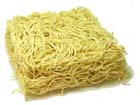Caramel sauce |
| Made of caramelized sugar and sometimes such ingredients as fish sauce and shallots. A common component in simmered dishes, where it brings out the flavor of other foods and lends them its golden color. |
Transparent noodles |
| Cellophane noodles (also known as bean threads, bean thread noodles or glass noodles), are a type of clear Asian noodle made from mung bean starch, water, and sometimes also other ingredients including potato starch. In Chinese, they are called ??? (lu dòu miàn; mung bean noodles; literally green bean noodles), or ?? (fen si). They are generally sold in dried form, boiled to reconstitute, then used in soups, stir fried dishes, or spring rolls. They are called cellophane noodles because of their resemblance to cellophane, a transparent material. |
Bean Thread noodles |
 | Bean thread noodles are thin, transparent noodles made from ground mung beans (small, khaki green legumes). They’re used in a variety of Asian dishes and are most often added to soups. |
Mung bean noodles |
| Mung bean noodles are the starch of mung beans. They are clear in color and bland in flavor. |
Pancit |
 | Pancit is a long, thin noodle, common in the Philippines, though of Chinese origin. This food is second in popularity to rice in the country. |
Kare-kare |
| Kare-kare is a Philippine stew or curry. Any Filipino fiesta, particularly in the Tagalog region, is not complete without kare-kare, which is made with a variety of vegetables. It is made from a peanut sauce (sometimes spiced with chili), stewed ox tail, goat, chicken or beef, bagoong and occasionally offal or tripe. |
Tinolang tahong |
| A soup made with Mussels. |
Inihaw na talong |
| A dish which is broiled eggplant with chopped tomato, onions and bagoong |
Lumpiang sariwa |
| Lumpiang sariwa are like crepes (rice/egg pastry) filled with Chinese vegetables and topped with peanut sauce |
Fried Lumpia |
| Lumpia is the Filipino word for spring roll. It is a popular Filipino food, and though the process of making one has been introduced by the Chinese as early as the 16th century, it has grown increasingly Filipino over the years, in taste and in style of preparation. The term lumpia, spelled as loempia, also has become the generic name for spring roll in Dutch. |
|






